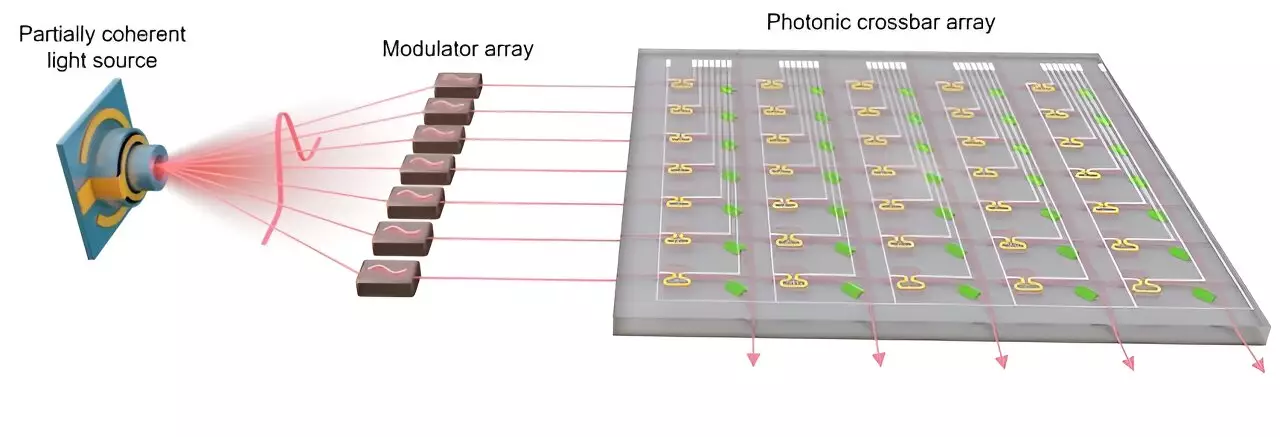In a groundbreaking study published in *Nature*, researchers from the University of Oxford, in collaboration with esteemed institutions such as the Universities of Muenster, Heidelberg, and Ghent, have shattered long-held myths about coherence in light sources. The research centers around the compelling idea that less sophisticated light sources can outperform their high-end laser counterparts in specific optical applications, particularly in light-driven artificial intelligence (AI) technologies. This pivotal discovery not only challenges established assumptions in photonic computing but also suggests a significant shift towards more accessible and energy-efficient technologies.
Historically, the conversation surrounding optical technologies was dominated by the supremacy of lasers—highly coherent light sources known for their narrow wavelength emissions and impressive precision. This conventional belief posited that greater coherence equated to better performance, driving the reliance on lasers in applications ranging from telecommunications to medical diagnostics. However, the Oxford study introduces a provocative counterpoint: in scenarios such as photonic AI accelerators, lower-coherence light sources can enhance performance substantially.
From Conventional Wisdom to Innovational Paradigm
Low-coherence light sources, such as sunlight and incandescent bulbs, emit a broad spectrum of wavelengths, which traditionally has been viewed as a limitation. Yet, the Oxford team’s research flips this narrative on its head, demonstrating that these “poorer” light sources can yield surprising advantages when strategically utilized. The researchers employed a partially coherent light source generated from an electrically pumped erbium-doped fiber amplifier—an innovative approach that harnessed just a slice of incoherent light spectrum to maximize the efficiency of AI computations.
This unraveling not only has implications for the realm of photonic AI but also challenges existing methodologies across various optical systems. Professor Harish Bhaskaran aptly notes that this newfound understanding could potentially reframe how optical communications and interconnects are designed, moving toward a more versatile and scalable future. The scalability factor is crucial; using a partially coherent light source means that as more input channels are added, the computational capacity can be enhanced exponentially.
Breaking Speed Barriers in AI Computation
The experiment conducted showcased how leveraging a partially coherent light system could significantly elevate the speed of AI computations, boasting an astonishing rate of 100 billion operations per second—akin to processing over two hours of 4K video in just one second. Such speeds have previously been attainable only through complex arrays of coherent lasers, thus limiting accessibility and increasing operational costs. By simplifying the architectural necessities of these systems, this innovation could democratize photonic computing, making it more viable for a broader range of applications.
One particularly notable application presented was the use of this technology in diagnosing Parkinson’s disease through gait analysis, boasting a classification accuracy exceeding 92%. This represents not merely a technical advance but a step toward integrating cutting-edge technology into real-world healthcare solutions. The operational efficiency gained from utilizing low-coherence light sources could serve as a vital force in the ongoing battle against this debilitating condition, pushing the boundaries of what is possible in disease detection and analysis.
The Future of Photonic Applications: A Paradigm Shift
The implications of this research extend well beyond the confines of AI and disease detection. They hint at a larger paradigm shift in the optical realm. As industries strive to maximize computational power while minimizing costs and energy consumption, the potential for partially coherent light sources could redefine standards across numerous fields—from telecommunications to robotics.
The bridge from high-spec lasers to simpler light systems signifies more than a technological upgrade; it signifies a philosophical re-examination of what constitutes “optimal” in an era where efficiency and accessibility reign supreme. By exploring the unique properties of low-coherence light, researchers can unlock a treasure trove of potential applications that could profoundly change the landscape of photonic technologies.
This research invites further inquiry into the vast world of light sources, leading to a future where photonic systems are not just faster and cheaper, but also smarter and more adaptable. The insights gleaned from this study might well guide the trajectory of optical technology for decades to come, making this an exhilarating time for both researchers and practitioners in the field.

